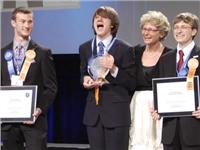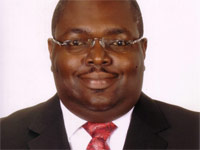
PITTSBURGH, Pa., May 18, 2012 – Jack Andraka, 15, of Crownsville, Md. was awarded first place for his new method to detect pancreatic cancer at this year’s Intel International Science and Engineering Fair, a program of Society for Science & the Public. Based on diabetic test paper, Jack created a simple dip-stick sensor to test blood or urine to determine whether or not a patient has early-stage pancreatic cancer. His study resulted in over 90 percent accuracy and showed his patent-pending sensor to be 28 times faster, 28 times less expensive and over 100 times more sensitive than current tests. Jack received the Gordon E. Moore Award, named in honor of Intel co-founder and retired chairman and CEO of $75,000.
Two students, Nicholas Schiefer, 17, of Pickering, Ontario, Canada and Ari Dyckovsky, 18, of Leesburg, Va., each received the Intel Foundation Young Scientist Award of $50,000.
Nicholas studied what he calls “microsearch,” or the ability to search the fastest-growing information medium: small amounts of content, such as tweets and Facebook status updates. Through his research, Nicholas hopes to improve search engines’ capabilities, which will in turn improve access to information.
Ari investigated the science of quantum teleportation. He found that once atoms are linked through a process called “entanglement,” information from one atom will just appear in another atom when the quantum state of the first atom is destroyed. Using this method, organizations requiring high levels of data security, such as the National Security Administration, could send an encrypted message without running the risk of interception because the information would not travel to its new location; it would simply appear there.
“We support the Intel International Science and Engineering Fair because we know that math and science are imperative to future global growth,” said Wendy Hawkins, executive director of the Intel Foundation. “This competition encourages millions of students to engage their skills for innovation and develop promising solutions for global challenges.”
This year, more than 1,500 young scientists were chosen to compete in the Intel International Science and Engineering Fair. They were selected from 446 affiliate fairs in approximately 70 countries, regions and territories. In addition to the winners mentioned above, more than 400 finalists received awards and prizes for their groundbreaking work. Awards included 17 “Best of Category” winners who each received a $5,000 prize. The Intel Foundation also awarded a $1,000 grant to each winner’s school and to the affiliated fair they represent.
Society for Science & the Public, a nonprofit membership organization dedicated to public engagement in scientific research and education, owns and has administered the International Science and Engineering Fair since its inception in 1950, as the National Science Fair.



